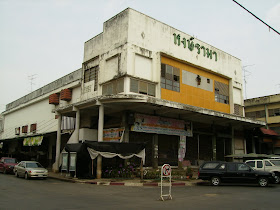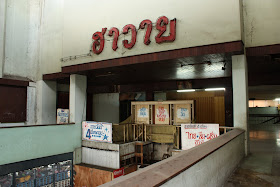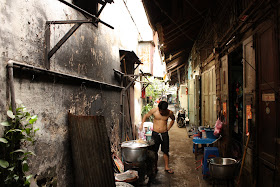Just a hop, skip and jump away from the Siam Theater stands its slightly younger sister, the Lido Theater. This was Apex's second Siam Square operation.

 For a little historical perspective, when the Lido opened on June 27th, 1968, Thailand was well into its transformation from a primarily agriculture-based economy to an industrial one. This transformation was spearheaded largely by American economic patronage in a Cold War setting. In Bangkok, sections of the city were being reequipped to handle a car-oriented infrastructure, as factories began springing up on the urban fringe.
For a little historical perspective, when the Lido opened on June 27th, 1968, Thailand was well into its transformation from a primarily agriculture-based economy to an industrial one. This transformation was spearheaded largely by American economic patronage in a Cold War setting. In Bangkok, sections of the city were being reequipped to handle a car-oriented infrastructure, as factories began springing up on the urban fringe.
The 1950's, 60's and 70's were the years of the movie palaces in Thailand. And like the palaces of the nobility, these luxurious theaters represented much more than the neighborhoods they stood in. They represented Bangkok, the industrial city, center of commerce in a modernizing country. They were adored and utilized by millions of Bangkokians, not to mention the many international visitors the city hosted. Sadly, however, for the most part, their time in the sun was short lived. The same forces that brought them into existence ultimately made them obsolete, as Bangkok and the other Thai cities home to stand-alone movie palaces developed in ways that were incompatible with maintaining them.
 Ask anybody over age 40 in Bangkok about the old palatial stand-alones like the Paramount, the Grand, the Coliseum, or the Chalerm Thai and you're bound to get a story, if not an all-out tangent. One time I was buying a bunch of bananas from a street vendor across from the MBK shopping mall. Just out of curiosity, I asked the vendor if he knew anything about the old stand-alones that used to be in the neighborhood. The guy literally started to jump around, ecstatically recounting the names of his favorite, now-destroyed theaters from the past. Then, before his outburst was through, he pointed a long, bony finger in the direction of the massive MBK shopping mall, with its SF Cinema City multiplex occupying the top floor. "I don't like those," he lamented. "They're expensive and I just don't like them."
Ask anybody over age 40 in Bangkok about the old palatial stand-alones like the Paramount, the Grand, the Coliseum, or the Chalerm Thai and you're bound to get a story, if not an all-out tangent. One time I was buying a bunch of bananas from a street vendor across from the MBK shopping mall. Just out of curiosity, I asked the vendor if he knew anything about the old stand-alones that used to be in the neighborhood. The guy literally started to jump around, ecstatically recounting the names of his favorite, now-destroyed theaters from the past. Then, before his outburst was through, he pointed a long, bony finger in the direction of the massive MBK shopping mall, with its SF Cinema City multiplex occupying the top floor. "I don't like those," he lamented. "They're expensive and I just don't like them."As for the Lido, although it's now a three-screen cineplex, when it opened it boasted of a single screen complete with Cinerama projection and nearly one thousand seats. Some 20 years ago, however, it was severely damaged by fire. When it was rebuilt they chopped the auditorium up into three, bringing it to its current state.
 The good people over at Apex ensure that the Lido, as well as its two single-screen brothers in the area, screen a much wider array of films than is typically shown in the shopping malls. My last time there I watched The Great Buck Howard, directed by Tom Hanks and starring John Malkovich, which I'm reasonable sure was the only screen that played it in the entire country.
The good people over at Apex ensure that the Lido, as well as its two single-screen brothers in the area, screen a much wider array of films than is typically shown in the shopping malls. My last time there I watched The Great Buck Howard, directed by Tom Hanks and starring John Malkovich, which I'm reasonable sure was the only screen that played it in the entire country. Anyway folks, the Lido Theater: since 1968 providing first-class entertainment for all.
Anyway folks, the Lido Theater: since 1968 providing first-class entertainment for all.












































